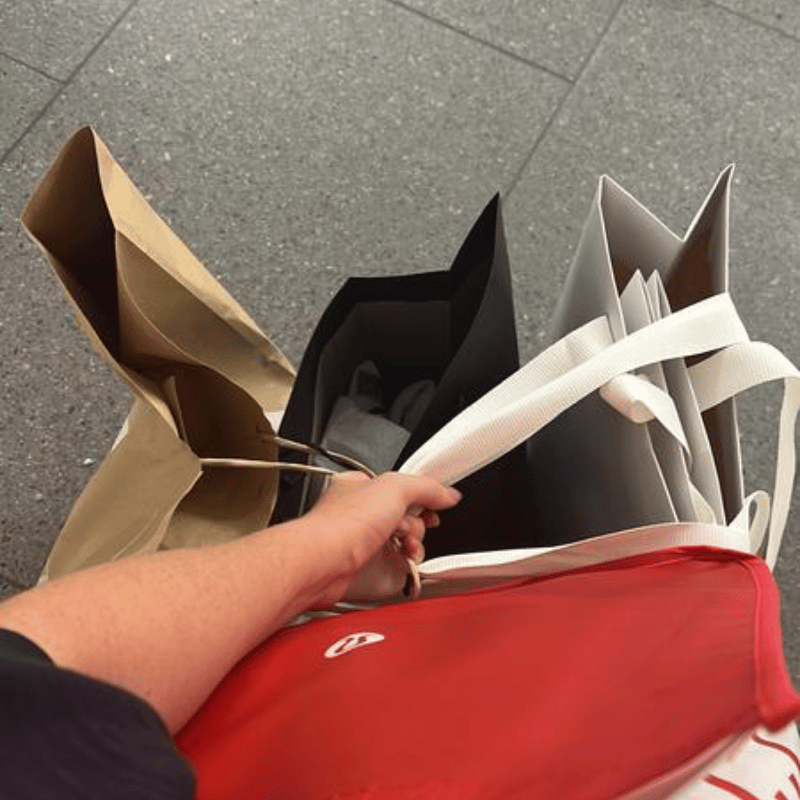- Clothes
- Bags
- Accessories
-
Inspiration
- Shoes
Ethical Wardrobe in a Cost-of-Living Crisis? How to Save Money

It can feel harder to be sustainable with our clothes during a cost-of-living crisis.
So, if you’ve been trying to ditch fast fashion but those €100 ethical clothes make your stomach sink as you put your card back into your wallet… We get it.
But there are ways to stay true to your beliefs when funds are running low and everything feels uncertain. In some cases? You might even end up saving money by embracing sustainable fashion (yes, for real).
Here’s how you can maintain a budget-friendly sustainable wardrobe during a cost-of-living crisis.
We know: during a cost-of-living crisis, fast fashion feels like the only option

We used to create moodboards and wishlists with our friends, saying “We’re going to look soooo good when we’re rich.”
Sadly, we never had enough money to invest in our style. So, fast fashion brands like Zara and Mango weren’t just a handy alternative: they felt like a godsend! The style of our dreams for our shoestring budgets? Yes, pleeeeeeeease.
Of course, this was before we discovered the high cost behind cheap fast fashion clothes (and eventually founding Project Cece, this fair fashion finder), but we often think about it now that there is such a spike in costs and we're in the midst of a cost of living crisis.
After all, ethical clothes tend to be more expensive. So, with rising living costs and less disposable income (and uncertain political situations or one unprecedented event after the other), over 6 in 10 consumers are now prioritising price over sustainability. No wonder brands like Zara made record profit in 2024.
But the problem with fast fashion?
- It’s terrible for the environment and leads to tonnes of waste (92 millions a year, specifically)
- It’s usually made by workers (including children) trapped in modern slavery conditions. These are mostly women and often subjected to abuse. So, when people say “There are more urgent things and human rights to worry about than fast fashion”, we always think of them (and fast fashion is a feminist issue!)
- It affects your brain: because it feels good at first but keeps you unhappy in the long run, it traps you in a cycle of needing to buy new clothes to get that dopamine hit
- It can actually cost you a lot more money (and we’ll show you why, soon)
Sustainable fashion vs cost-of-living crisis: how to maintain an eco-friendly and ethical wardrobe on a budget

First of all, a disclaimer: not everyone can afford to drop €100 on a new ethical garment right now, regardless of how long they keep it for. We fully acknowledge that.
But if you’re used to buying new fast fashion clothes every month, the chances are… you will save money and feel happier once you switch to sustainable fashion. And sustainable fashion isn’t about buying new clothes, anyway.
Saving (or making) money right now
- Identify your signature style – When you get clear on what clothes (don’t) feel like “you”, it’s easier to break free from trends and endless impulse purchases
- Declutter your wardrobe and resell some clothes – When you get rid of clothes that no longer match your style (you know, the ones you always find excuses not to wear), sell them on platforms like Vinted and Depop. You’ll make some extra money and reduce the environmental footprint of those garments by keeping them in circulation for longer
Embracing sustainable fashion for free
- Rewear your clothes – As teased before, it’s not necessarily about buying new garments: the most sustainable item is the one that’s already in your wardrobe. While brands and influencers try to convince you that you must always be seen wearing different clothes, rebel by falling in love with your current ones. And we promise: when you open your wardrobe and only find items that match your style? You’ll feel happier whenever you rewear them!
- Create new outfits using your existing clothes – Repeat outfits aside, you can create completely different looks by simply pairing up your garments with different items, layers, and accessories. And before you think it’s a given, have you actually tried it (as in, playing with combinations you had never thought of before)? If you’re more of a visual person, you could digitise your closet with free apps like Whering and Save your Wardrobe
- Swap clothes – You can do this on a 1:1 basis (how about asking that friend who’s your same size and also passionate about ethical fashion?) or by organising a clothing swap party
- Sharpen your DIY skills – For example, mend your existing clothes (instead of immediately giving up on them and spending more money to replace them) or upcycle them into new ones, like turning an old blouse into a top
Embracing sustainable fashion on a budget
- Try peer-to-peer renting – With platforms like Hurr, Rent the Runway, and By Rotation, you can save money (and reduce your environmental footprint) by renting certain garments, especially those you’d only wear once or twice, like for special occasions
- Shop the most budget-friendly ethical brands – On Project Cece, use our Price filter to browse the collections of hundreds of sustainable brands while only focusing on clothes within your budget
Saving money in the long run with sustainable fashion
- Focus on cost per wear – Yes, when clothes are made ethically, they’re more expensive, but their cost-per-wear tends to be much lower because they’re made to last (not to fall apart after a few wearings, like fast fashion garments), and even more so if you keep them for years. For example:
- The cost-per-wear of a high-quality ethical jumper (€80) you’ve already worn 20 times? €4
- A €15 fast fashion jumper bought on a whim and only worn twice because it doesn’t match your style? €7.50, and that’s without considering the fact that you’ll probably buy a new jumper to replace it - Buy less but better – Only invest in sustainable pieces you’ll happily rewear at least 30 times
- Prioritise versatile clothes – When you buy one monochrome garment or a particularly versatile design? You usually get to create multiple new outfits by pairing up with your existing clothes!
On Project Cece, you can browse the collections of hundreds of ethical brands, using filters (including Price) to simplify your choices.
As we said before: there are exceptions, but in most cases, when you start from what you already own and only buy new clothes mindfully, you can maintain a sustainable wardrobe—even during a cost-of-living crisis.
Share our story
Related articles
How YOU Can Afford a Sustainable Wardrobe (& Save Money)
Ethical clothes cost more, but fast fashion latter is probably costing you a lot more money! So, here's how to afford a sustainable wardrobe [+ cheaper brands]
Cost Per Wear: What It Is & How It Makes Slow Fashion Cheaper
Ditch cheap fast fashion clothes, choose higher-quality ethical garments, and… save money in the long run! Here’s the difference that cost per wear makes.
Affordable Sustainable Clothing: 6 Brands Not Costing the Earth
Yes, affordable sustainable clothing DOES exist. But you need to know where to look—and change your mindset. Start from our simple guide & best brands.
Project Cece is a platform that collects ethical fashion from vetted brands and shops in one place. Browse ethical fashion for women and men and find items that fit your style, budget and values!
_large.png)


